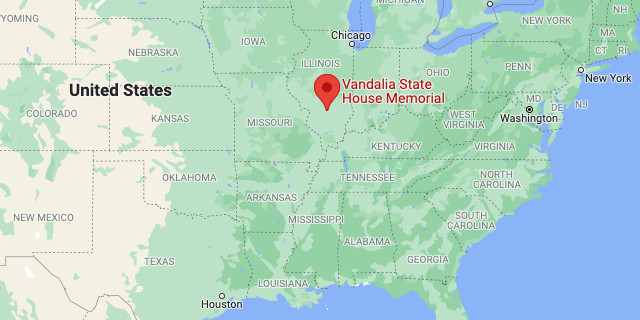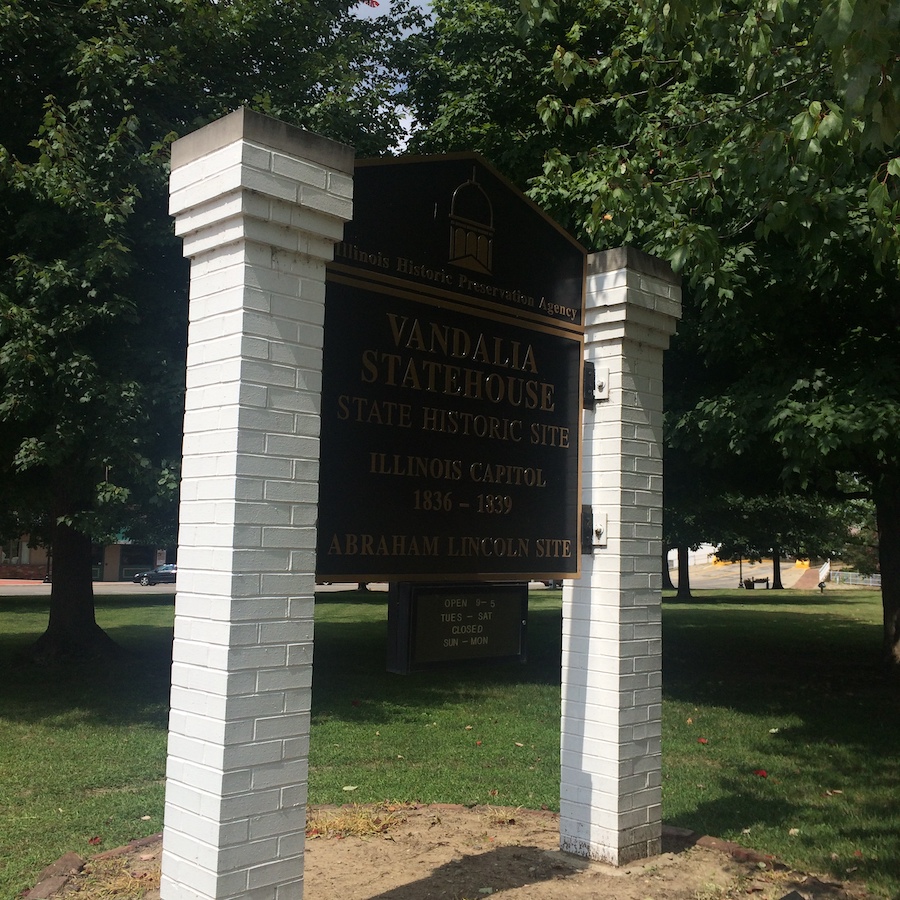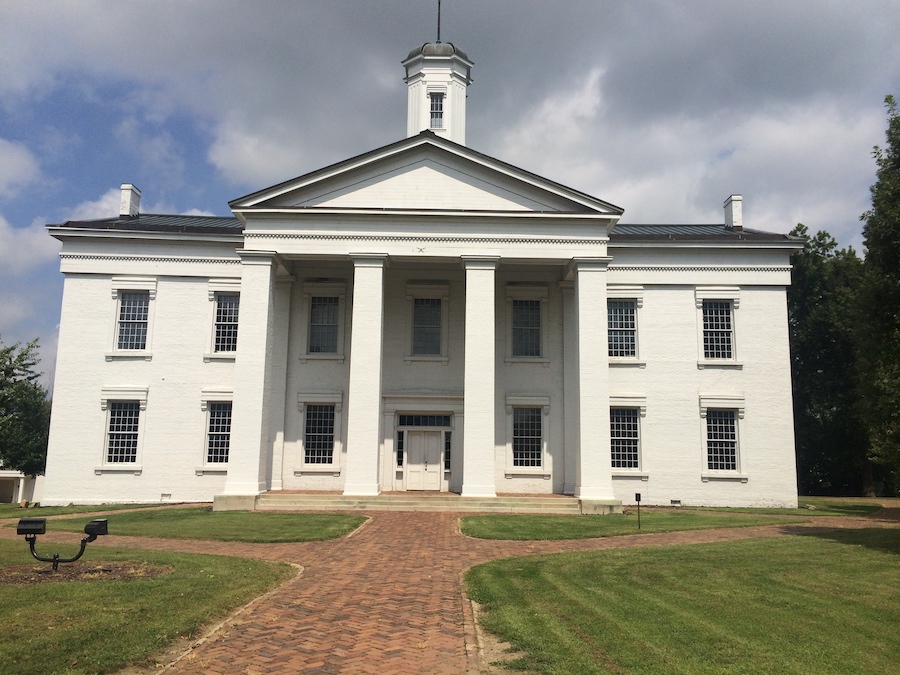| The Vandalia State House: |
|---|
|
|
|
|
Vandalia's businessmen had an idea:
When the legislature was in 1836 recess, they abruptly tore down the third Capitol building and built a larger fourth one on the same public square. They wanted to make it so nice to work in that it would encourage the state government to remain in town.
It didn't work:
|
|

https://www.google.com/maps/place/Vandalia+State+House+Memorial
T
he Vandalia State House, the fourth Illinois statehouse, served as the capitol from 1836 until 1839.
It is the oldest surviving capitol building in the state:
- Illinois' first capital (1818-1820) was at Kaskaskia
- The second (1820-1823) was at Vandalia
- The third (1824-1836) was at Vandalia
- The fourth (1836-1839) was at Vandalia
- The fifth (1839-1876) is in Springfield and is preserved as the Old State Capitol State Historic Site
- The sixth is the current capitol (1876-present) in Springfield
The Vandalia State House is significant for its association with Abraham Lincoln, who served in the House of Representatives.
The first floor contains a large entry hall and rooms representing the offices of the Auditor, Treasurer, and Secretary of State, as well as the Supreme Court chamber. The second floor is composed of a central hall and recreated House and Senate chambers, each of which contains a visitor gallery reached by staircases.
https://www2.illinois.gov/dnrhistoric/Experience/Sites/Southwest/Pages/Vandalia-StateHouse.aspx
The Vandalia State House, Illinois's fourth capitol, was built when Illinois was in its eighteenth year as a state.Vandalia State House State Historic Site:
- The Vandalia State House, built in 1836, is the fourth capitol building of the U.S. state of Illinois.
- It is also the oldest capitol building in Illinois to survive, as the first, second, and third capitol buildings have all disappeared.
- The brick Federal style state house has been operated by the state of Illinois as a monument of Illinois pioneer years since 1933
- Admitted to the Union in 1818, Illinois quickly abandoned its first governmental center of Kaskaskia, and its capitol building (active in 1818–1820).
- A second "state house" was built of lumber at the new capital of Vandalia, but it burned to the ground after only three years (1820–1823).
- The third capitol building (1824–1836), also built in Vandalia, was the scene of most of the service of Abraham Lincoln as a member of the Illinois state legislature.
Lincoln did not, however, become a beloved figure in Vandalia. He was elected from Sangamon County, closer to Springfield the geographic center of Illinois. Lincoln led a central Illinois caucus that called for the state government to move itself to the growing town of Springfield.
- As a result of this threat, Vandalia businessmen took action. In 1836, when the legislature was in recess, they abruptly tore down the third Capitol building and built a larger fourth one on the same public square.
Vandalia hoped that the new Vandalia State House would be so nice to work in that it would encourage the state government to remain in town.
The building the legislators entered in December 1836 did not have the front or rear portico. The cupola was octagonal and featured a rounded roofline. The brick building was not painted white. Legislators began the session upset by the presence of workmen and the odor of damp plasterWhen Lincoln and his colleagues returned to Vandalia in the fall of 1836, they saw the new "State House" waiting for them. They were not impressed. In February 1837, the legislature, under pressure from Lincoln and his colleagues, moved the governmental center to Springfield. The fifth Illinois capitol, a Springfield building now called the Old State Capitol State Historic Site, served that purpose from 1839 to 1876. It was then replaced by the sixth and current Illinois State Capitol, which has been occupied since 1876.
https://en.wikipedia.org/wiki/Vandalia_State_House_State_Historic_Site

State Historic Site
Illinois Capitol
1836 - 1839
Abraham Lincoln Site
The Vandalia Statehouse, constructed 1836, is the oldest surviving state capitol in Illinois
Illinois' first Statehouse:
- A rented building in Kaskaskia, stood for many years until, like the town itself, it was destroyed by the Mississippi River in the late nineteenth century.
- Kaskaskia served as state capital for only a few months following Illinois statehood (December 3, 1818).
Second Statehouse:
- During the first week of June 1819, four of the five commissioners elected by the first general assembly selected a site along the Kaskaskia River which, by constitutional fiat, would be the Illinois seat of government for twenty years.
- During the following months, the new town of Vandalia was established at the selected location.
The unusual name had been coined in the 1760s for the proposed fourteenth British Colony that was to be named Vandalia in honor of the queen of England, descended from the Vandal tribesAccording to legend, one of Vandalia's surveyors selected the name to denote both the progress of human endeavor at the capital (as in the word "vanguard") and the geographic unevenness (as in "hills and dales") of the attractive site.
According to another story, the name designated an ambiguously named site ("vanne delai") along the Kaskaskia that was known to traders several years prior to the 1819 selection.
- The second Statehouse, constructed by state authorization, stood for three years.
The Statehouse burned to the ground in December 1823 under suspicious circumstances related to the campaign
Third State House:
- Within two months of the statehouse fire, Vandalians began to construct a new facility.
- The new, two-story statehouse was centrally located in Vandalia's downtown area.
The building was razed five years before photography came to Illinois, and no drawings or paintings of the building are known to exist
- This capitol served six General Assemblies; here Lincoln began his political career in 1834.
- But in spite of the good intentions of the workers, the structure was unsubstantially and hastily constructed on low moist ground and without good cement.
- By the summer of 1836, local congregations refused to convene in the statehouse any longer for fear it would collapse upon them.
- The Senate floor had sunk seven inches during the past two years; the walls were cracked and damaged.
- William Walters, the editor of Vandalia's Illinois State Register, predicted the building would not stand until winter.
Fourth State House: The Vandalia Statehouse:
- The new statehouse measured 150 feet by 50 feet.
- The statehouse possessed a cupola, a gabled roof, and exterior walls of unpainted brick.
- Its front entrance faced Gallatin Street - Vandalia's main thoroughfare - and its rear entrance faced north to Main Street.
- The auditor, secretary of state, and treasurer had offices downstairs, as well as the Supreme Courts room.
- The Senate and House chambers were located upstairs, along with spectators' galleries.
- Exterior columns were added to the statehouse years later.
- No photographs of the statehouse in its original appearance have been found.
- It served as capitol for two General Assemblies:
- The Tenth (1836-37)
- The first session of the Eleventh (1838-39)
1839 Illinois Seat of Government moved to Springfield:
Vandalia's plat carried the date July 1819, and because all that was authorized by the constitution concerning a seat of government had been done by July 1819, then the twenty-year constitutional period concluded in July 1839.
The Senate approved the Committee's recommendation that Springfield be declared the seat of government and seat of the Supreme Court as of July 4, 1839.
https://www2.illinois.gov/dnrhistoric
315 West Gallatin Street
Vandalia, Illinois 62471










